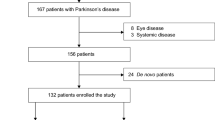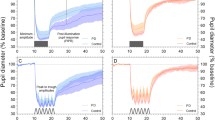Abstract
Dopamine was shown to induce mydriasis by excitation of alpha-adrenergic receptors at the dilator pupillae muscle. Pupilla diameter may thus serve as an indirect measure of peripheral pharmacokinetics of l-DOPA and dopamine. The aim of this study is to evaluate the effect of l-DOPA dosage on pupillometric parameters in Parkinson’s disease (PD) patients. Sixteen PD patients and 14 healthy control subjects (CS) were studied. The statistical analysis revealed significant differences between CS and PD patients for the mean maximum and minimum pupil diameters (p = 0.017, p = 0.028, respectively), with higher values found in PD. Moreover, a significant dose–response relationship was found between the maximum pupil diameter and both the morning l-DOPA dose (R 2 = 0.78) and the total daily l-DOPA dose (R 2 = 0.93). A sigmoid-shaped curve best describes the dose–response relationship, with a ceiling effect at about 400 mg l-DOPA daily dose. In conclusion, measuring pupillometric parameters represents a sensitive tool for non-invasive evaluation of the peripheral effect of l-DOPA, especially with daily doses below 400 mg l-DOPA.


Similar content being viewed by others
Change history
11 April 2018
Unfortunately, original article has been published without acknowledgement section.
Abbreviations
- BDI:
-
Beck depression inventory
- CS:
-
Control subjects
- D1, D2:
-
Dopamine receptors
- DIF:
-
Difference between MAX and MIN
- FAB:
-
Frontal assessment battery
- MAX:
-
Maximum pupil parameter
- MIN:
-
Minimum pupil parameter
- MMSE:
-
Mini-mental state examination
- PD:
-
Parkinson’s disease
- R 2 :
-
R-squared for nonlinear regression
- T :
-
Latency for the onset of constriction
- UPDRS:
-
Unified Parkinson’s disease rating scale
- VAR:
-
Variation ((MAX − MIN)/MAX) × 100
- VCmax :
-
Maximum constriction velocity
References
Fotiou F, Goulas A, Fountoulakis K, Koutlas E, Hamlatzis P, Papakostopoulos D (1998) Changes in psychophysiological processing of vision in myasthenia gravis. Int J Psychophysiol 29(3):303–310
Fotiou DF, Stergiou V, Tsiptsios D, Lithari C, Nakou M, Karlovasitou A (2009) Cholinergic deficiency in Alzheimer’s and Parkinson’s disease: evaluation with pupillometry. Int J Psychophysiol 73(2):143–149
Giza E, Fotiou D, Bostantjopoulou S, Katsarou Z, Karlovasitou A (2011) Pupil light reflex in Parkinson’s disease: evaluation with pupillometry. Int J Neurosci 121(1):37–43
Giza E, Fotiou D, Bostantjopoulou S, Katsarou Z, Gerasimou G, Gotzamani-Psarrakou A, Karlovasitou A (2012) Pupillometry and 123I-DaTSCAN imaging in Parkinson’s disease: a comparison study. Int J Neurosci 122(1):26–34
Gordan R, Gwathmey JK, Xie LH (2015) Autonomic and endocrine control of cardiovascular function. World J Cardiol 7(4):204–214
Jain S (2011) Multi-organ autonomic dysfunction in Parkinson disease. Parkinsonism Relat Disord 17(2):77–83
Langer SZ (1980) Presynaptic regulation of the release of catecholamines. Pharmacol Rev 32(4):337–362
Matouskova O, Slanar O, Chytil L, Perlik F (2010) Pupillometry in healthy volunteers as a biomarker of tramadol efficacy. J Clin Pharm Ther 36(4):513–517
Micieli G, Tassorelli C, Martignoni E, Pacchetti C, Bruggi P, Magri M, Nappi G (1991) Disordered pupil reactivity in Parkinson’s disease. Clin Auton Res 1(1):55–58
Navailles S, Carta M, Guthrie M, De Deurwaerdere P (2011) l-DOPA and serotonergic neurons: functional implication and therapeutic perspectives in Parkinson’s disease. Central Nerv Syst Agents Med Chem 11(4):305–320
Poewe W, Seppi K, Tanner CM, Halliday GM, Brundin P, Volkmann J, Schrag AE, Lang AE (2017) Parkinson disease. Nat Rev Dis Primers 3:17013
Shannon RP, Mead A, Sears ML (1976) The effect of dopamine on the intraocular pressure and pupil of the rabbit eye. Invest Ophthalmol 15(5):371–380
Slanar O, Nobilis M, Kvetina J, Idle JR, Perlik F (2006) CYP2D6 polymorphism, tramadol pharmacokinetics and pupillary response. Eur J Clin Pharmacol 62(1):75–76 (author reply 77–78)
Slanar O, Nobilis M, Kvetina J, Mikoviny R, Zima T, Idle JR, Perlik F (2007) Miotic action of tramadol is determined by CYP2D6 genotype. Physiol Res 56(1):129–136
Spiers AS, Calne DB, Vakil SD, French TM (1971) Action of thymoxamine on mydriasis induced by levodopa and dopamine. Br Med J 2(5759):438–439
Stergiou V, Fotiou D, Tsiptsios D, Haidich B, Nakou M, Giantselidis C, Karlovasitou A (2009) Pupillometric findings in patients with Parkinson’s disease and cognitive disorder. Int J Psychophysiol 72(2):97–101
Tambasco N, Romoli M, Calabresi P (2017) Levodopa in Parkinson’s disease: current status and future developments. Curr Neuropharmacol. https://doi.org/10.2174/1570159X15666170510143821
Velasco M, Luchsinger A (1998) Dopamine: pharmacologic and therapeutic aspects. Am J Ther 5(1):37–43
Author information
Authors and Affiliations
Corresponding author
Ethics declarations
Conflict of interest
The authors declare that they have no conflict of interest.
Rights and permissions
About this article
Cite this article
Bartošová, O., Bonnet, C., Ulmanová, O. et al. Pupillometry as an indicator of l-DOPA dosages in Parkinson’s disease patients. J Neural Transm 125, 699–703 (2018). https://doi.org/10.1007/s00702-017-1829-1
Received:
Accepted:
Published:
Issue Date:
DOI: https://doi.org/10.1007/s00702-017-1829-1




